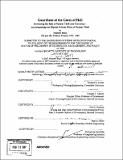| dc.contributor.advisor | Richard K. Lester. | en_US |
| dc.contributor.author | Bunn, Matthew | en_US |
| dc.contributor.other | Massachusetts Institute of Technology. Technology, Management, and Policy Program. | en_US |
| dc.date.accessioned | 2008-11-10T19:53:25Z | |
| dc.date.available | 2008-11-10T19:53:25Z | |
| dc.date.copyright | 2007 | en_US |
| dc.date.issued | 2007 | en_US |
| dc.identifier.uri | http://dspace.mit.edu/handle/1721.1/39006 | en_US |
| dc.identifier.uri | http://hdl.handle.net/1721.1/39006 | |
| dc.description | Thesis (Ph. D.)--Massachusetts Institute of Technology, Engineering Systems Division, Technology, Management, and Policy Program, 2007. | en_US |
| dc.description | Includes bibliographical references (p. 419-466). | en_US |
| dc.description.abstract | Methods are presented to assess the global risk of nuclear theft and nuclear terrorism, to identify the nuclear facilities and transport legs that pose the highest-priority risks of nuclear theft, and to evaluate policy approaches to strengthening security and accounting for nuclear stockpiles worldwide. First, a qualitative assessment outlines the demand for black-market nuclear weapons and materials; the plausibility of terrorist construction of an improvised nuclear device; the global stocks and flows of nuclear weapons, plutonium, and highly enriched uranium (HEU), with the global distribution of facilities where they exist; and the widely varying standards of physical protection, control, and accounting in place to prevent theft. Particular dangers of nuclear theft in Russia, Pakistan, and from HEU-fueled research reactors are highlighted. Second, a mathematical model of the global risk of nuclear terrorism is presented, with detailed assessments of what is known about the values of each of the parameters, and of policies that could change each of the parameters to reduce risk. | en_US |
| dc.description.abstract | (cont.) Third, a methodology for identifying the nuclear facilities and transport legs posing the highest risks of nuclear terrorism is presented, combining the security levels for each facility or transport leg, the levels of threat they face, and the quantity and quality of nuclear weapons or weapons-usable material they contain. Fourth, the global nuclear security system is described and assessed as a complex, large-scale, integrated, open system (CLIOS). Based on past experiences with different policy tools from negotiated international standards to on-the-ground technical cooperation to install improved security equipment, options to improve system performance in reducing the risk of nuclear terrorism are assessed. A final chapter offers conclusions and recommendations. | en_US |
| dc.description.statementofresponsibility | by Matthew Bunn. | en_US |
| dc.format.extent | 466 p. | en_US |
| dc.language.iso | eng | en_US |
| dc.publisher | Massachusetts Institute of Technology | en_US |
| dc.rights | M.I.T. theses are protected by
copyright. They may be viewed from this source for any purpose, but
reproduction or distribution in any format is prohibited without written
permission. See provided URL for inquiries about permission. | en_US |
| dc.rights.uri | http://dspace.mit.edu/handle/1721.1/39006 | en_US |
| dc.rights.uri | http://dspace.mit.edu/handle/1721.1/7582 | en_US |
| dc.subject | Technology, Management, and Policy Program. | en_US |
| dc.title | Guardians at the Gates of Hell : estimating the risk of nuclear theft and terrorism -- and identifying the highest-priority risks of nuclear theft | en_US |
| dc.type | Thesis | en_US |
| dc.description.degree | Ph.D. | en_US |
| dc.contributor.department | Massachusetts Institute of Technology. Engineering Systems Division | |
| dc.contributor.department | Technology and Policy Program | |
| dc.identifier.oclc | 166577269 | en_US |
